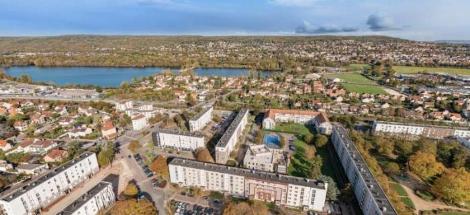La « Cite du Parc » - Grand Paris Seine et Oise urban community
Regenerating the city’s priority neighbourhoods #2
January 2024
Agence nationale de la cohésion des territoires (ANCT)
As part of the Fabrique Prospective, each inter-municipality supported set up a local working group made up of around fifteen stakeholders of its choice. The Ellyx and Oxalis consortium ran four local seminars in each area to help the working groups look to the long term and co-construct a programme of actions to be carried out in the short term around the four themes of the Fabrique Prospective:
-
Amplifying the ecological transition of the QPVs ;
-
The emergence and development of new economic activities based on nature in the inner suburbs;
-
The social link and participation of residents in public life;
-
Strengthening territorial cohesion, i.e. the links between the QPVs and their surrounding areas.
Feedback from the Grand Paris Seine et Oise urban community in the Paris region
To download : vernouillet_-_cite_du_parc.pdf (4 MiB)

Located in the Yvelines department, the Grand Paris Seine et Oise (GPSEO) urban community comprises 73 municipalities, including Vernouillet, covering 504.7 km2 with a population of just over 424,510 in 2019. Although located in a dense urban area, Vernouillet has the largest protected agricultural zone in the Île-de-France region. GPSEO has twelve QPVs (neighbourhoods of prime importance) with a combined population of over 61,000.
The Cité du Parc is the only district in Vernouillet. In 2020, it was home to almost 2,500 residents, or around 24% of the commune’s population. The district is separated from the Seine by the Transilien J line. The Cité du Parc was built by architect Charles-Gustave Stoskopf on the grounds of the Château de Vernouillet park. The district comprises 868 social rental dwellings (owned by CDC Habitat Social and Logirep) and one condominium. CDC Habitat owns and manages most of the outdoor areas (foot of buildings, extensive lawns). As part of the Prior’Yvelines programme to boost residential supply in the Yvelines, run by the Conseil départemental, GPSEO and the commune of Vernouillet are receiving financial support for the transformation of the Cité du Parc district.
The project includes revising traffic patterns to open up the area, renovating housing, making homes accessible to people with reduced mobility, integrating a commercial centre and mixing housing types (73 new homes, 2/3 of which are social home ownership), etc. A participatory process involving 600 people was carried out by the municipality in 2022. The various consultation workshops resulted in proposals relating to housing (cool islands, green spaces, etc.), the commercial centre (delivery arrangements and parking management, maintaining a public square for the market and festive events, etc.), the relocation of the social centre, street furniture and lighting, and public facilities (play areas, city stadium, etc.).
As part of the Fabrique Prospective, Sandrine Loembe and Isabelle Martin, elected members of Vernouillet town council, in conjunction with the director of urban policy and social cohesion, brought together around forty stakeholders (decentralised government departments, social landlords, tenants’ association, local associations, municipal and inter-municipal departments, departmental council, residents, etc.). They co-constructed their ideal vision of the district by 2035, based on three key themes:
-
A neighbourhood that fosters social interaction and territorial cohesion: the esplanade has become a place where local residents and the community can come together by creating spaces that improve the quality of life (creation of a floral park and shared vegetable gardens, reintroduction of animal and plant species, etc.). This is an ideal place to create a link between residents and nature. Greenways have been laid out to encourage links between the district and the surrounding area;
-
A neighbourhood that encourages agriculture: communal vegetable gardens, communal composters and rainwater harvesters have been installed in the neighbourhood;
-
a district adapted to heat waves (buildings and streets), in particular through the development of nature-based solutions.
To translate this vision into action, the local councillors and stakeholders have identified three key areas for action:
-
transforming the park from the château to the old lawns. This is a multi-faceted approach. Through the planting of vegetation, the idea is to respond to the challenges of biodiversity and therefore of the ecological transition (dealing with heat islands), of social cohesion through participative activities (planting, maintenance, botanical discovery) and of territorial cohesion through embellishment that encourages people to visit the area.
-
buildings - renaturation, biodiversity and energy efficiency. As part of the urban renewal project, environmental and energy issues were taken into account by those involved in the existing and future buildings. This has led to this area of work being given priority. This involves setting action frameworks that position the ecological transition as a priority and integrating consultation forums into project management practices.
-
soft and active mobility, based on the renaturation of traffic routes: opening up biodiversity corridors and creating islands of coolness on soft mobility routes that contribute to the ecological transition; making these routes connections that contribute to territorial cohesion; identifying facilities for learning to cycle, creating a route dedicated to active mobility, creating a green cycle route through the district.